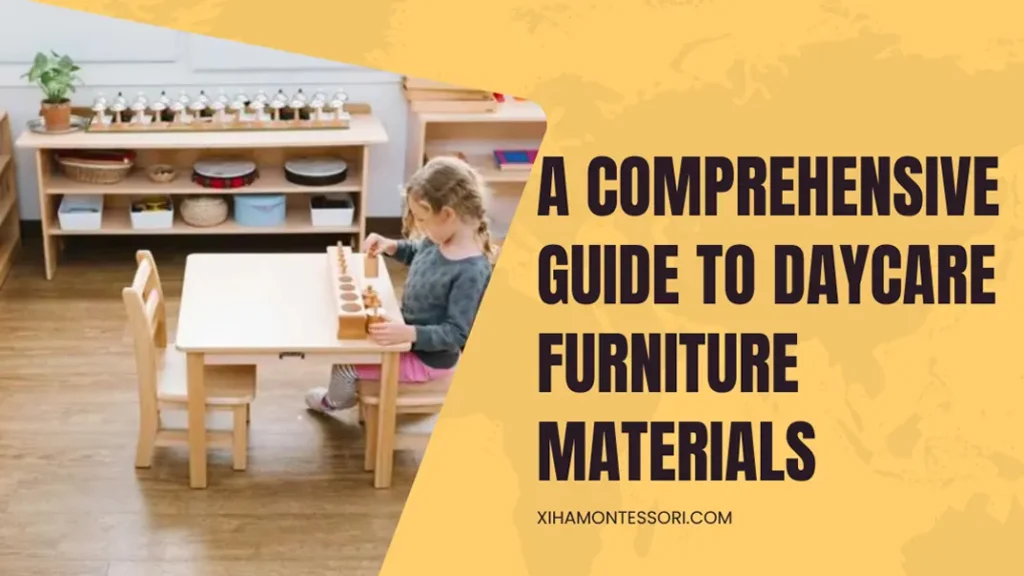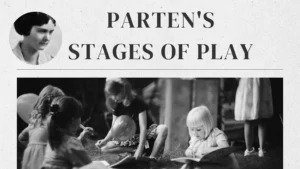Welcome to our comprehensive guide to daycare furniture materials! This article will explore the various materials used in daycare furniture and their unique benefits. Whether you’re looking to furnish a new daycare center or update an existing one, understanding the materials available is essential to making an informed decision.
The best daycare furniture materials strike a balance between durability, safety, and aesthetics. Wood, plastic, and metal are the most commonly used materials, each with distinct advantages. Choosing the right one depends on your budget, long-term maintenance goals, and the activity level in your daycare environment.
This guide will help you determine which materials are best suited for different types of daycare furniture, including tables, chairs, cribs, play equipment, and storage units. By the end of this guide, you will have a comprehensive understanding of daycare furniture materials, allowing you to choose the right options for your specific needs.
Factors to Consider When Choosing Daycare Furniture Materials
Choosing the right materials for daycare furniture involves evaluating several factors beyond aesthetics. Here are seven key factors to consider:
1. Safety
Safety is the number one priority when choosing daycare furniture materials. Furniture should be free from sharp edges and toxic chemicals. Look for non-toxic finishes and ensure the materials meet relevant safety standards, such as those set by the CPSC (Consumer Product Safety Commission) and ASTM (American Society for Testing and Materials). Consider materials that are hypoallergenic and flame-retardant.
2. Durability
Daycare furniture will experience heavy use daily, so durability is a crucial consideration. Materials like solid wood and metal are known for their strength and longevity, making them ideal for high-traffic areas. Plastic, while more affordable, may wear down faster and must be replaced more frequently. Investing in more durable materials upfront can save you from having to replace furniture as often.
3. Maintenance
The ease of cleaning and maintaining daycare furniture materials is another key factor. Plastic and metal are relatively low-maintenance, requiring only regular cleaning with a damp cloth. On the other hand, wood may require periodic refinishing or polishing to maintain its appearance. Fabric furniture, while comfortable, can be more challenging to clean and may need regular washing or spot-cleaning to prevent stains.
4. Aesthetics
The material you choose can greatly impact the look and feel of your daycare. Wood provides a natural, warm, inviting look that makes a space feel more comfortable. Plastic and metal, on the other hand, offer bright, vibrant, and modern designs that can energize a room. Fabric adds softness and comfort, especially in seating areas.

5. Budget
Your budget will play a significant role in determining which materials are right for your daycare. Solid wood tends to be the most expensive option, but its durability may make it a better long-term investment. Plastic and composite materials offer more affordable alternatives, though they may need to be replaced more often.
6. Environmental Impact
For eco-conscious daycare providers, the environmental impact of the materials is an important consideration. Look for sustainably sourced materials, such as FSC-certified wood, or recycled options like recycled plastic. Metal can be recycled at the end of its life cycle, making it a more sustainable choice. Fabric choices made from organic or eco-friendly materials can also reduce environmental harm.
7. Comfort
Children spend long hours in the kindergarten environment, so comfort is essential. Fabric-covered seating can offer a soft and cozy option, while hard materials like metal and plastic may need cushions to improve comfort.
Common Daycare Furniture Materials
Daycare furniture comes in many shapes, sizes, and materials. Each material offers unique benefits and drawbacks. Look at the five most common types: wood, plastic, metal, composites, and fabric.
1. Wood
Wood is one of the most classic and popular materials for preschool furniture. It’s valued for its warmth, natural aesthetics, and durability. The tactile feel of wood can make furniture more inviting while also contributing to a comfortable and homely daycare environment.
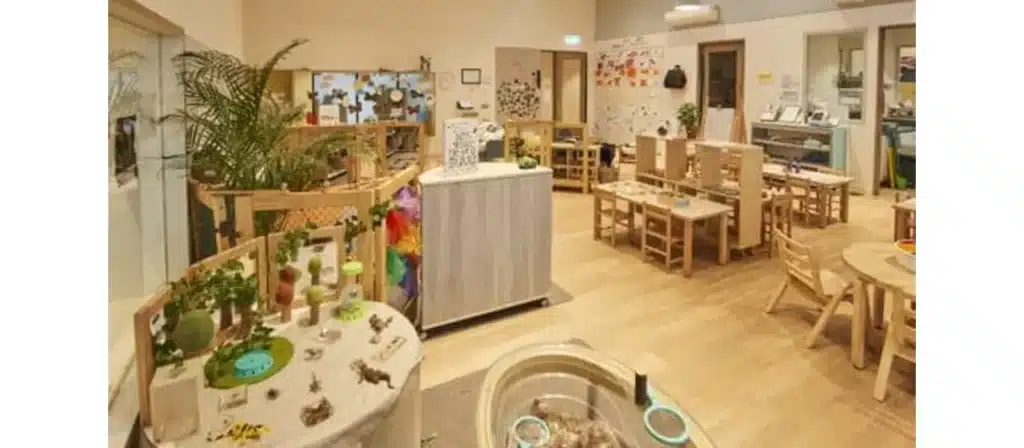
- Types of Wood Used: The most common woods used in daycare furniture are solid hardwoods like oak, maple, birch, and beech. Plywood or MDF is often used in more affordable options or for pieces requiring more shape flexibility.
- Pros: Wood is strong and long-lasting. Solid wood furniture can withstand years of use and can be refinished or repaired when needed, giving it an extended lifespan. Wood also offers a natural, organic aesthetic that creates a warm and inviting environment, ideal for a daycare setting.
- Cons: Wood is durable but prone to scratches and dents, especially in high-traffic areas. Wood furniture may also require more maintenance, such as sanding and refinishing, to keep it looking new. Additionally, it can be more expensive than other materials like plastic or composite.
2. Plastic
Plastic furniture has become increasingly popular in daycare settings due to its versatility and affordability. Plastic is available in an array of vibrant colors, which makes it a great choice for creating a bright, child-friendly atmosphere.
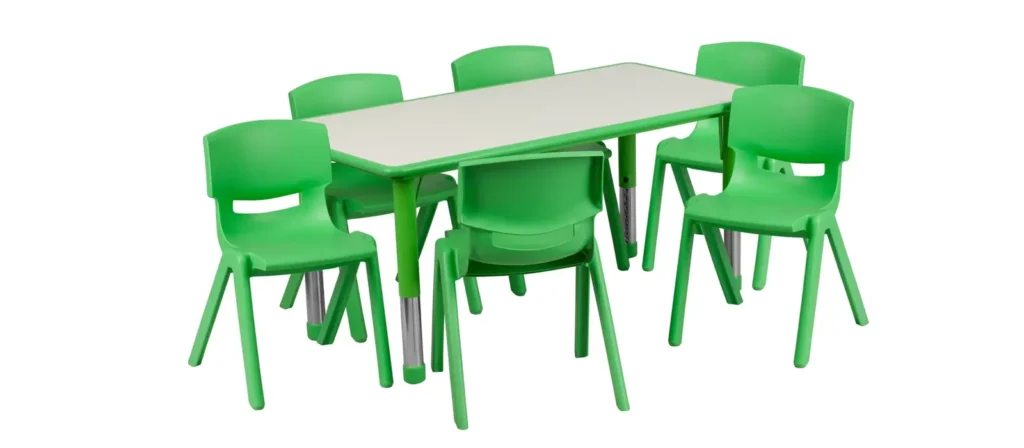
- Types of Plastic Used: The two most common types of plastic used in daycare furniture are polypropylene and polyethylene. These materials are lightweight, durable, and easy to mold into various shapes.
- Pros: Plastic is affordable, lightweight, and highly resistant to stains and spills—ideal for a daycare setting where messes are inevitable. It’s also available in various colors and designs, allowing for more creativity in furniture styles. Plastic furniture is easy to clean with just soap and water, and it doesn’t require the regular maintenance that wood or metal might need.
- Cons: While durable, plastic can crack or become brittle over time, especially when exposed to extreme temperatures or sunlight. It doesn’t have the same aesthetic appeal or long-term durability as wood or metal. Over time, plastic furniture may need to be replaced more frequently than other materials.
3. Metal
Metal is often used in daycare furniture for its strength and longevity. It is primarily used for structural components like frames and full furniture like shelving units, tables and chairs.
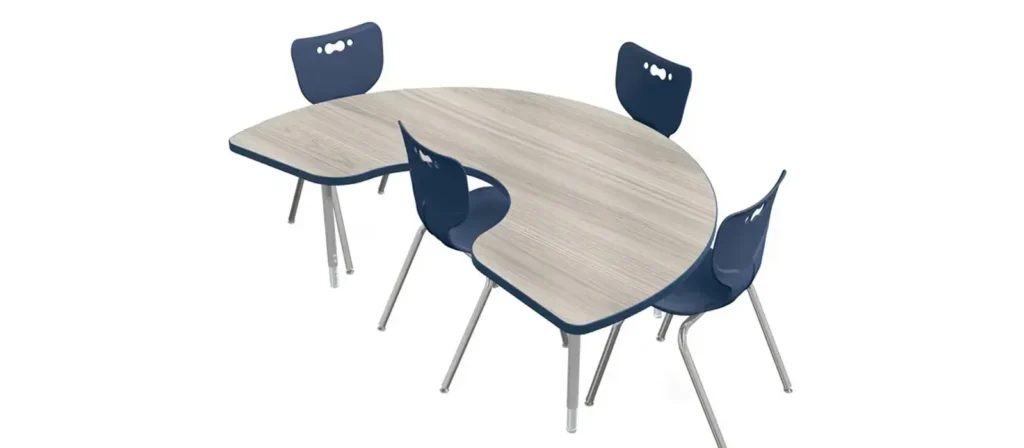
- Types of Metal Used: Steel and aluminum are the most common metals in preschool furniture. Steel provides excellent strength, while aluminum is lightweight and resistant to rust.
- Pros: Metal furniture is solid and resistant to everyday wear and tear damage. It is typically used for frames or support structures in furniture pieces that need to hold up to frequent use. Metal is also easy to clean, non-porous, and can be powder-coated in various colors to match the aesthetic of the child care.
- Cons: Metal furniture can feel cold and industrial, which may not be as inviting for children. It also can be heavier than plastic or composite materials, making it less easy to move around. If not properly treated or coated, metal can rust, particularly in areas with high humidity.
4. Composites
Composite materials combine wood fibers, plastic, or other materials bonded together to create an affordable yet durable option. These are widely used for affordable daycare furniture with a balance of strength and cost-efficiency.
- Types of Composites Used: MDF (Medium-Density Fiberboard) and particleboard with laminate finishes are the most common composite materials used in daycare furniture.
- Pros: Composites offer a more affordable alternative to solid wood while still providing good durability. They can be easily shaped and are often used for larger furniture such as shelving, cubbies, and storage units. Laminate finishes can provide a variety of colors and textures, giving the appearance of wood without the cost.
- Cons: Composites are generally not as durable as solid wood. They can swell or deteriorate if exposed to moisture. They also may lack natural wood’s aesthetic quality and feel, and their surfaces can chip or peel over time.
5. Fabric
Fabric is important in creating soft, comfortable seating options in daycare settings. It is typically used for padded chairs, cushions, and soft seating areas like reading nooks.
- Types of Fabric Used: Common fabrics used in daycare furniture include polyester, cotton blends, and microfiber. These materials are chosen for their durability and ease of cleaning.
- Pros: Fabric is soft and comfortable, providing a cozy spot for children to sit and relax. It’s also available in various colors and patterns, allowing customization to fit the daycare’s design. Modern fabrics are designed to be stain-resistant and easy to clean, making them practical for high-use areas.
- Cons: Despite its comfort, fabric can be more prone to stains, spills, and wear. It often requires regular cleaning and can absorb odors. Fabric seating may need to be replaced more often than plastic or metal, especially in busy daycare settings.
Environmental Impacts of Different Materials
Choosing sustainable materials is beneficial for the environment and important for promoting responsible consumption. Here’s a breakdown of how different materials impact the environment.
- Wood: If sourced responsibly, wood is one of the most sustainable options. Look for FSC-certified wood to ensure it comes from well-managed forests. However, excessive use of wood without proper sourcing can contribute to deforestation.
- Plastic: Traditional plastic production is based on petroleum, making it less eco-friendly. However, choosing recycled plastic can significantly reduce its environmental footprint.
- Metal: Metal can be highly sustainable as it’s recyclable. Choosing furniture made from recycled steel or aluminum can minimize the environmental impact.
- Composites: While composites like MDF are often made from recycled materials, they may include synthetic glues and less environmentally friendly finishes.
- Fabric: Fabric can have a mixed environmental impact. Natural fabrics like cotton or wool are biodegradable but may require more water and energy. Synthetic fabrics like polyester are less sustainable, but recycled polyester offers a greener alternative.
How Do Different Materials Affect Long-Term Costs?
The cost of daycare furniture is not limited to the initial purchase. The long-term maintenance, repair, and replacement costs should also be considered.
- Wood: While expensive upfront, wood furniture can last many years if properly maintained, making it a cost-effective long-term investment.
- Plastic: Plastic is generally cheaper than other materials but may need to be replaced more frequently, especially in high-traffic areas.
- Metal: Metal is more durable than plastic or composite materials, lowering long-term replacement costs. It’s a solid investment for areas that experience heavy use.
- Composites: Composites are more affordable but may require frequent replacements, particularly if exposed to moisture or heavy wear.
- Fabric: Fabric can be inexpensive but requires regular cleaning and may wear out more quickly, leading to higher long-term costs for replacement or reupholstering.

Popular Daycare Furniture Suppliers
If you’re looking for a reliable supplier of daycare furniture, Xiha Montessori is a trusted brand. Xiha Montessori produces high-quality, durable, and customizable furniture, specializing in Montessori and daycare furniture and offering a wide variety of products designed to meet the unique needs of early education environments.
- Customization: Xiha Montessori offers ODM/OEM services that allow customers to customize furniture to their specific requirements. Whether you need customized sizes, finishes, or additional features, Xiha can meet these needs with precision and attention to detail.
- Quality Assurance: With strict quality control processes and internationally recognized certifications, you can be confident that Xiha’s furniture meets the highest safety and durability standards. Each piece is rigorously tested to ensure it is safe for children.
- Durable Materials: Xiha uses quality materials such as FSC-certified wood and high-density plastics to ensure your furniture is environmentally friendly and durable.
- Global Reach: Xiha serves customers from the U.S., Canada, Australia, Singapore, and more and has extensive experience managing international orders from production to delivery.
- Professional service: Xiha’s customer service team ensures that every process step, from consultation to after-sales support, is seamless with efficient and clear communication.
Offering everything from classroom desks and chairs to lockers and play equipment, Xiha Montessori is your go-to supplier for quality, safe, and durable daycare furniture.
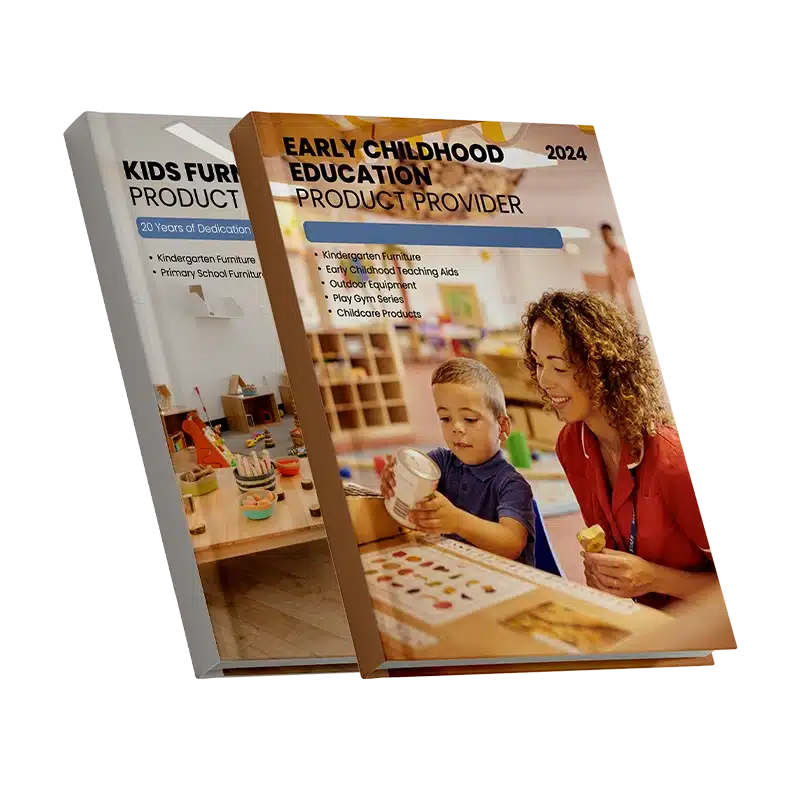
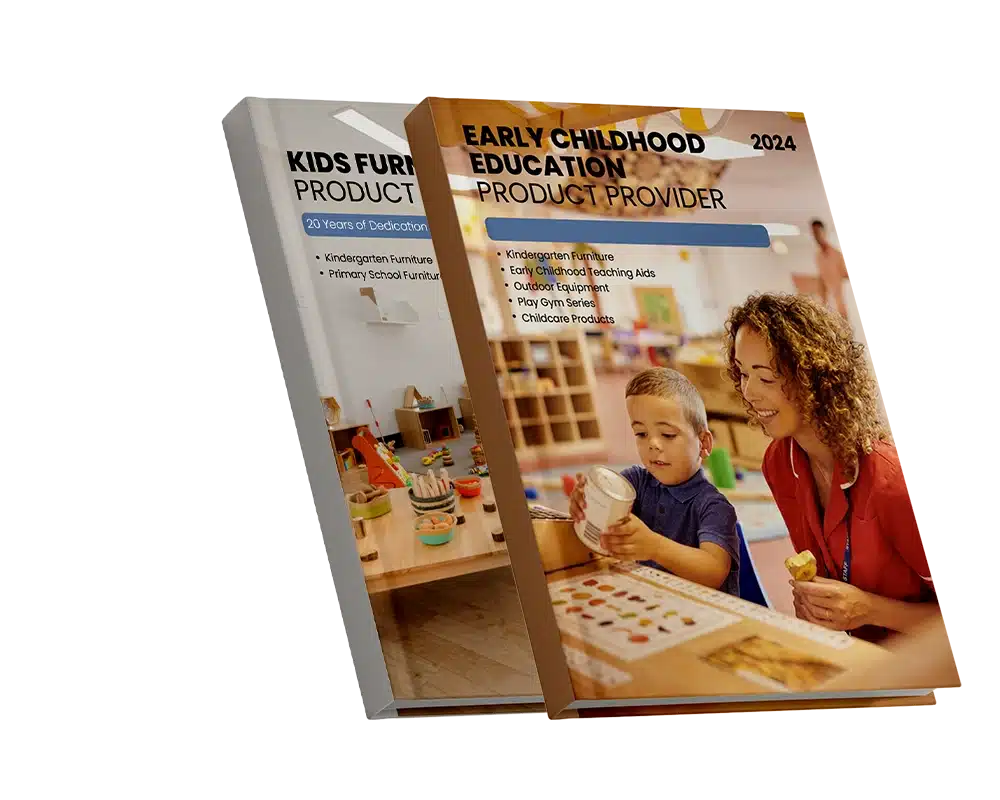
Daycare Furniture Materials FAQs
Here are some frequently asked questions to guide your decision-making process further.
1. Which Materials Are Easiest to Clean?
Plastic and metal are the easiest to clean, requiring only a quick wipe-down. Fabric may require frequent washing, and wood should be treated carefully to avoid water damage.
2. How to Balance Cost and Quality When Purchasing Daycare Furniture?
Look for composite materials or a mix of metal and plastic for cost-effective, durable furniture. Higher upfront costs in materials like wood may save you money in the long run due to their durability.
3. What Are Some Eco-Friendly Options?
Choose FSC-certified wood, recycled plastic, or recycled metal for sustainable choices. Additionally, fabrics made from organic or recycled fibers offer greener alternatives.
4. What Certifications Should Daycare Furniture Have?
Look for furniture that meets safety standards from ASTM, CPSC, or equivalent international organizations to ensure it’s safe for children.
5. What Are the Best Material Options for Outdoor Daycare Furniture?
Plastic and metal are the best choices for outdoor furniture as they can withstand moisture and sunlight. Ensure that plastic is UV-resistant to prevent fading.
Conclusion
Choosing the right materials for daycare furniture can significantly affect your space’s functionality and atmosphere. Each material has advantages and disadvantages, from classic wood to modern plastic and metal. Prioritizing safety, durability, and ease of maintenance will ensure you make the best choice for your daycare.
Understanding the materials available allows you to create a safe, engaging, and long-lasting environment for children to thrive in.

